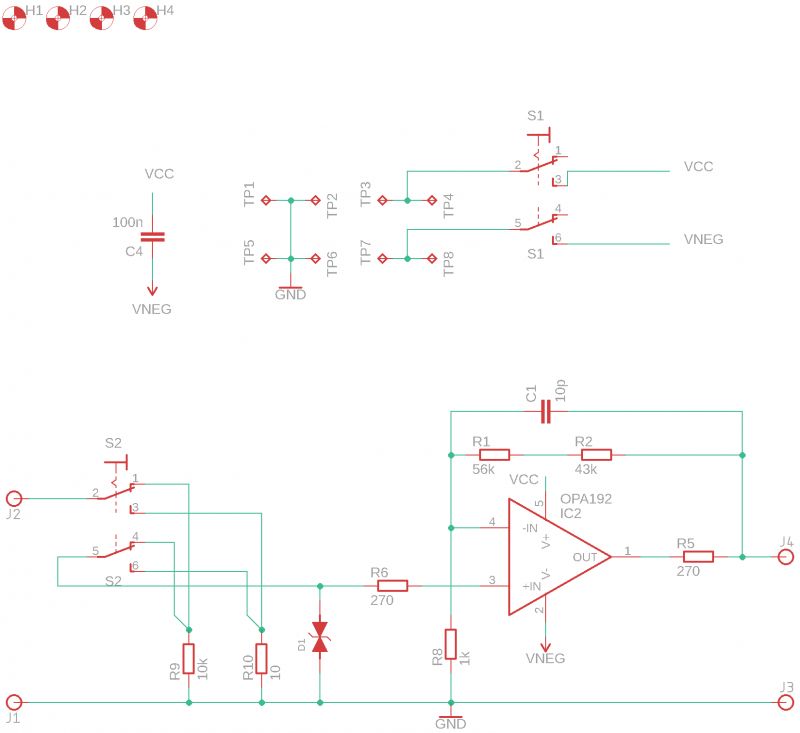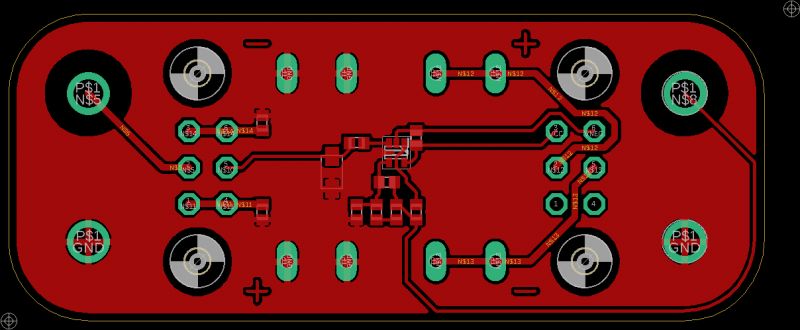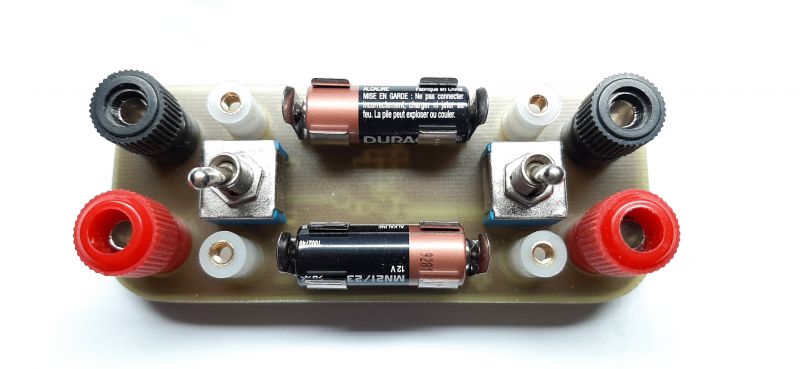uCurrent for the poor - an adapter for measuring small currents

I came across a project once David Jones uCurrent .
All in all, it is a very simple system. Voltage is deposited on the measuring resistor, which is then amplified x100 and fed to the output.
Unfortunately, the item is not cheap, about 70 EUR excluding shipping costs.

I decided to make my version, slimmer, cheaper, but with similar (or even better in some respects) parameters.
What did I not like about the original?
- Power. One CR2032 battery and artificial zero. The circuit is complicated (like one opamp, but always), and the power supply of the output amplifier is only +/- 1.5 V.
- The use of two expensive and hard to reach opamps in the amplifier. The cascade circuit improves the frequency response a little compared to one amplifier with higher gain, but is megahertz important, for example, when measuring the current consumed by the circuit in the sleep state?
Changes made by me:
- Two ranges instead of three. Each multimeter measures the milliamps, and for the oscilloscope you can use a resistor in series.
- Easily available operational amplifier - you can buy it at TME.
- Power supply from two 12 V batteries. This gives an output voltage range from 0 to 10,000 mV, so in the nA range I can measure currents from 0 to 10 uA, and in the uV range up to 10 mA. This is 10 times more than the original.
- Place for a diode protecting the amplifier input. Just in case.
- I also resigned from the battery voltage monitoring system.
Thus, the layout was created as in the diagram. Simple, not to say primitive.

The value of the capacitor C1 has been transferred from the original schematic - if necessary, I will try to improve the compensation using a generator and an oscilloscope.
A tile pattern was created behind the diagram. As the scheme is simple, the board came out in one layer without any problems, without combining with bridges etc. Easy to make at home.

And then the layout itself.


0.1% resistors
Time for measurements:
The offset voltage is less than 1 mV. With the input shorted, the output voltage fluctuates in the range of 0.3 to 0.8 mV.
The accuracy of indications is surprisingly high, better than 0.5%. But I assume it will be safe to assume 1%. Calculated using the technical method, because I have nothing to calibrate this device with. Yet the meters I use to measure voltage and resistance have their limitations.
The voltage source was a 3V battery, a current limiting resistor in series and my adapter. The voltage is measured at the ends of this series circuit, and its total resistance, including the leads, is measured with a multimeter.
For the uA range:
At the entrance = 3.1630 V, R = 99 890 ?
And the theory. = 31.6 uA
And d. = 31.8 uA
error = 0.42%
For the nA range:
At the entrance = 2.9434 V, R = 5134000 ?
And the theory. = 573.3 nA
And d. = 574.4 nA
error = 0.19%
Enough for me.



Comments
1. How with the stability with ordinary resistors? 2. Are these metal plates short-circuiting the metal housing of the battery? - just scratch the paint. [Read more]
The original has a near-zero DC offset and drift through the use of autocorrelating zeroing techniques ", how can the effects be affected by using OPA192 instead of MAX4239? Maybe you will make a wider... [Read more]
OPA192 landed there a bit by accident. Now I see that TME has MAX4239 in SO8 housing, but I didn't see it then (or it wasn't on offer). Besides, its power supply is +/- 2.75 V maximum, so I would... [Read more]
If you wanted to share the project with more people, the "kit" would actually be better than the assembled product, while banana connectors, as you write, are optional, what is important is PCB, acrylic,... [Read more]
A great project and such gadgets I would like to see in the elektroda.pl store ;) Where did you get these battery holders? I'm looking for those, but with AAA batteries, and I can't find som... [Read more]
https://www.tme.eu/pl/details/keys82/baterie-pojemniki-i-uchwyty/keystone/82/ This particular model fits AAA, N, and A23, which is exactly 12V. The only difference is the "length" spacing. https://obrazki.elektroda.pl/7141301100_1605207005_bigthumb.jpg... [Read more]
Congratulations on a successful project! I have a question because I am building something similar only on the LF356, namely what is the measurement bandwidth, could a colleague measure with a current... [Read more]
AVE ... A very nice alternative, although I personally will not find it useful. Plus, absurdly cheap. I always thought the original uCurrent was a little too expensive compared to its intended use. Autozero... [Read more]
But why? Secondly, it will not compensate for it as there are amplifier inputs, it is better to give an amplifier with processing. [Read more]
Here you are. https://obrazki.elektroda.pl/4282371600_1605256653_bigthumb.jpg Bandwidth varies greatly depending on the range. In the uA range it is only 73 kHz. The rise time of the impulse response... [Read more]
AVE ... @Janusz_kk I was thinking about something like this: https://obrazki.elektroda.pl/8384328200_1605269099_thumb.jpg Q1 and Q2 should be glued together, as well as Q3 and Q4. R1 and... [Read more]
I guessed :) except that this system does not exist here, this is how the oscilloscope inputs are made, which must be high ohmic, but here the gain from it is negligible, because we do not need such a... [Read more]
In the diagram @Urgon is the LF356 which has this feature: "JFET Input Operational Amplifier". I am also eager to find out why it is worth adding a handful of discrete elements to add a JFET buffer... [Read more]
AVE ... There is an error in the feedback circuit in the diagram - wrong resistor values and wrong connection layout. You're right, it doesn't make sense a bit to be honest. I used the schematic... [Read more]
Hello Today you can buy good amplifiers looking at temperature drifts etc. In the past, these inventions did not exist and you had to deal with them :) In the Czech Amaterkie Radio there was an excellent... [Read more]
AVE ... IN one episode of EEVBlog a meter is shown which has a current range of 100 attoamps, or 0.0001 pA. JFET input stage, all spider-soldered on probably polyester supports. [Read more]
Very interesting. Interesting resistance at the input. But for such ranges it is probably not strange. [Read more]
AVE ... I will add one more curiosity from the 1960s: a circuit with an input impedance of more than 1 T?, an output impedance of 50 ? with a voltage gain of 0.98. https://obrazki.elektroda.pl/2485299900_1605909539_thumb.jpg... [Read more]
The value of the resistor on the gate of the BFX63 transistor makes it difficult to buy in a local electronics store (there probably still existed in those years). I understand that this is not a DC ... [Read more]